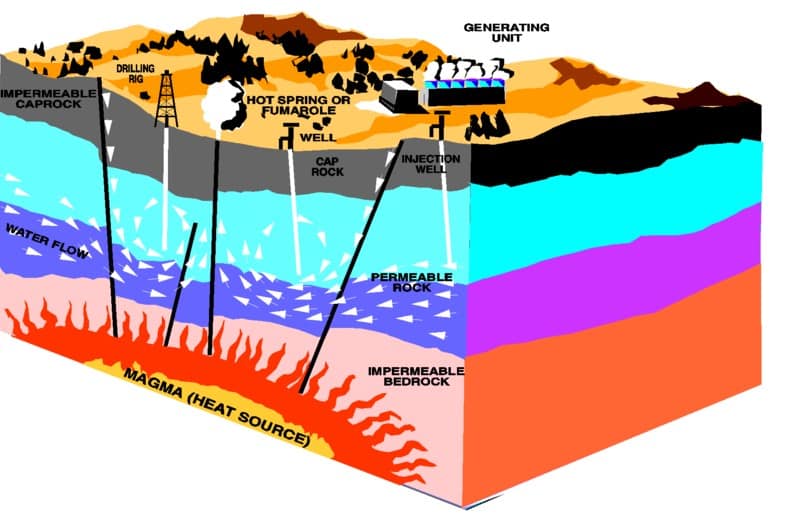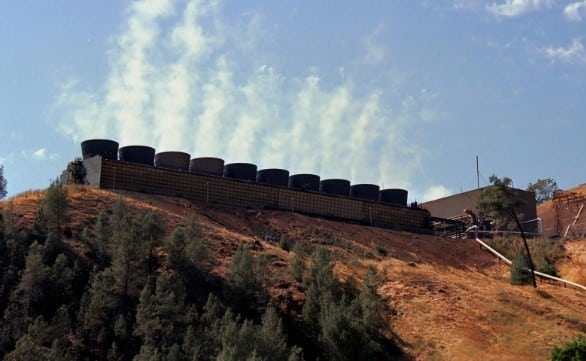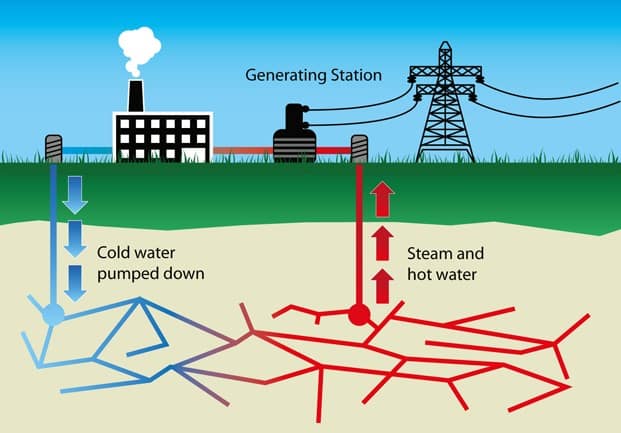Is Geothermal Energy Renewable Or Nonrenewable
Geothermal energy is a renewable energy source because it comes from the Earth’s core, which continuously produces heat. This heat is stored in rocks and fluids in the Earth’s core. Geothermal energy is not a fossil fuel, which is a finite resource that will eventually run out.
However, geothermal power plants that use steam or hot water from geothermal reservoirs to generate electricity are considered non-renewable resources. This is because geothermal reservoirs are finite and will eventually be depleted.
Geothermal energy is a type of renewable energy that utilizes the heat from the earth’s core to generate electricity. However, there has been an ongoing debate on whether geothermal energy should be classified as renewable or nonrenewable.
This article aims to explore both sides of the argument and provide a comprehensive understanding of geothermal energy.
On one hand, proponents argue that geothermal energy is a form of renewable energy because it uses the natural heat generated by the earth’s core, which is continuously replenished over time. Unlike fossil fuels such as coal and oil, which are finite resources that take millions of years to form, geothermal energy can be harnessed indefinitely without depleting its source. Additionally, with advancements in technology, it has become more accessible and cost-effective to extract this clean source of power.
On the other hand, some experts believe that certain types of geothermal plants may not be entirely sustainable due to their reliance on water reservoirs deep within the Earth’s surface. They argue that these reservoirs could eventually run dry if they are not managed properly, making geothermal energy a nonrenewable resource in those cases.

Definition And Explanation Of Geothermal Energy
Geothermal energy is a renewable source of power that comes from the natural heat within the earth’s core. This type of energy can be harnessed and used to generate electricity by utilizing hot water and steam found deep underground.
One advantage of geothermal energy is that it is an environmentally friendly alternative to fossil fuels, as it produces no harmful emissions or pollutants. Additionally, geothermal power plants have low operating costs and require little maintenance once they are up and running.
However, one disadvantage of this form of energy is that it can only be accessed in certain geographic locations where there are high concentrations of thermal activity. Furthermore, drilling for geothermal resources can sometimes cause earthquakes and release greenhouse gases into the atmosphere.

Characteristics Of Renewable Energy Sources
Renewable energy sources are becoming increasingly popular due to their sustainable and environmentally friendly nature. These types of energy come from natural resources that can be replenished over time, such as wind, solar, hydroelectric, geothermal, and biomass.
Advantages of renewable energy include reducing greenhouse gas emissions, creating job opportunities in the clean energy sector, promoting energy independence and security for countries who rely on foreign oil imports.
However, there are also some limitations when it comes to renewable energy sources. For example, they require a significant initial investment in infrastructure and technology. They may also be less reliable than traditional fossil fuels due to factors such as weather conditions or fluctuations in available resources.
When considering renewable energy options like geothermal power, it’s important to weigh both the advantages and limitations before making decisions about implementation. By doing so, we can work towards building a more sustainable future for generations to come without sacrificing our current needs for affordable and reliable energy sources.
Arguments For Geothermal Energy As A Renewable Resource
Geothermal energy is a renewable resource that has sparked interest in the past few years. It is an incredible source of clean and sustainable energy with several advantages over other forms of renewables such as solar, wind, or hydroelectric power. Here are some arguments for geothermal energy being a renewable resource:
| Advantages | Potential Limitations |
|---|---|
| Available 24/7 | 1. High upfront costs |
| Low greenhouse gas emissions | 2. Limited availability of suitable sites |
| Long lifespan of plants | 3. Risk of ground subsidence |
One advantage of geothermal energy is that it’s available continuously without any interruption as opposed to solar or wind power which can be affected by weather conditions. Another benefit is its low carbon footprint; geothermal power generates minimal amounts of greenhouse gases compared to fossil fuels like coal or natural gas, making it ideal for mitigating climate change concerns.
Despite its strengths, there are still potential limitations associated with this technology, including high initial capital costs required to build the infrastructure necessary for harnessing geothermal energy effectively. Additionally, finding appropriate locations for these facilities can be challenging due to geographic constraints and environmental regulations on land use policies restricting where they may be built.
In conclusion, despite having certain challenges and limitations, the benefits provided by geothermal power cannot be ignored when considering alternative sources of renewable energy production methods. The future prospects for this sector look promising as technological advancements continue to improve efficiency levels while reducing upfront expenditure requirements simultaneously enabling wider adoption rates among consumers globally seeking cleaner alternatives than traditional non-renewable options currently used today!
Arguments Against Geothermal Energy As A Renewable Resource
However, despite its advantages, geothermal energy is not without its flaws.
One argument against classifying it as a renewable resource is the environmental impact it can have. The drilling and extraction of geothermal energy can lead to soil erosion, water pollution, and even seismic activity in some cases. While these impacts may be minimal compared to those caused by non-renewable sources like coal or oil, they still pose a threat to local ecosystems.
Another issue with geothermal energy is its economic feasibility. Building and maintaining geothermal power plants can be costly due to the need for specialized equipment and skilled labor. Additionally, the availability of viable locations for geothermal plants may be limited, leading to higher transportation costs for materials and personnel.
These factors make it difficult for some countries or regions to fully embrace geothermal energy as their primary source of electricity generation. However, with continued research and development into more efficient technologies and methods of harnessing this natural resource, these challenges could potentially be overcome in the future.

Sustainability And Management Considerations
Geothermal energy is considered a renewable source of energy as it harnesses heat from the Earth’s core, which is constantly replenished. However, while geothermal energy itself may be sustainable, there are still challenges in managing and maintaining it to ensure its long-term sustainability.
One of the main sustainability challenges with geothermal energy is the potential for depletion or overuse of resources. This can happen if too much water or steam is extracted from underground reservoirs, causing them to dry up or become unstable. As such, resource management strategies must be carefully developed and implemented to ensure that extraction rates do not exceed natural recharge rates.
Additionally, proper monitoring and maintenance of infrastructure, such as wells and pipelines, are necessary to prevent leaks and other issues that could harm the environment around the geothermal site.
Geothermal plants require large amounts of land space. Drilling operations can cause environmental damage. High upfront costs for building power plants. Limited availability in certain geographic locations.
To mitigate these sustainability challenges, resource management strategies must prioritize responsible use and conservation of geothermal resources. This includes implementing technologies such as reinjection systems that recycle used water back into underground reservoirs to maintain their stability and prevent depletion.
Furthermore, continued research and development can help improve efficiency and reduce costs associated with geothermal energy production. Ultimately, careful planning and execution will be crucial in ensuring that geothermal energy remains a sustainable option for meeting our future energy needs.

Conclusion And Future Outlook For Geothermal Energy
As we have seen, geothermal energy is a highly promising and efficient source of renewable power. Geothermal technology has evolved over the years, making it more effective in harnessing Earth’s natural heat for electricity generation. However, despite its potential as an alternative to fossil fuels, geothermal energy remains largely untapped.
The global potential for geothermal energy is immense, with estimates suggesting that it could meet up to 10% of the world’s electricity demand. It is imperative that policymakers recognize this fact and invest in the development of geothermal projects.
With advances in drilling techniques and increased government support, we can unlock the full potential of geothermal energy and move towards a cleaner future without compromising on our energy needs.
Frequently Asked Questions

What Are The Specific Environmental Impacts Of Geothermal Energy Production?
Geothermal energy production has both positive and negative environmental impacts.
On the one hand, it is a renewable source of energy that emits almost no greenhouse gases.
However, geothermal pollution can occur when fluids from deep underground are brought to the surface during drilling or other activities associated with geothermal power plants.
These fluids may contain harmful chemicals such as heavy metals or hydrogen sulfide gas, which can pollute nearby water sources if not properly managed.
Additionally, geothermal drilling can cause earthquakes in some areas where tectonic plates are already under stress.
Despite these potential drawbacks, many experts believe that geothermal energy holds great promise for helping to mitigate climate change and reduce our reliance on fossil fuels.
Can Geothermal Energy Be Used In All Regions Of The World?
Just imagine a world powered by the earth’s natural heat, where energy is clean and limitless.
It may seem like an unattainable dream, but with exploring potential geothermal feasibility in all regions of the world, it could become our reality.
While some areas are better suited for geothermal power than others due to geological factors, advances in technology have made it possible to tap into this renewable resource even in previously thought unsuitable locations.
With continued research and development, we can unlock the full potential of geothermal energy and pave the way towards a more sustainable future.
How Does The Cost Of Geothermal Energy Compare To Other Renewable Energy Sources?
When it comes to renewable energy sources, geothermal is often overlooked in favor of solar and wind.
However, the cost of geothermal energy has been decreasing steadily over the years and can now compete with other renewables.
In fact, a recent report found that the levelized cost of electricity (LCOE) for geothermal was lower than that of solar and comparable to wind power.
Additionally, governments around the world are offering incentives such as tax credits and grants to encourage investment in geothermal projects.
So while some may question whether geothermal energy is renewable or nonrenewable, its cost competitiveness and government support make it an attractive option for clean energy production.
What Are Some Of The Technological Limitations Or Challenges Facing Geothermal Energy Production?
Exploration methods and resource characterization are two of the biggest technological challenges facing geothermal energy production.
Unlike other renewable sources, such as wind or solar power, geothermal resources are not always easily accessible or predictable.
In order to locate viable sites for drilling, advanced exploration techniques must be employed, which can be costly and time-consuming.
Additionally, accurately characterizing a geothermal reservoir is crucial in determining its potential output and lifespan.
Without a thorough understanding of these factors, it becomes difficult to optimize production and ensure long-term viability.

How Does The Use Of Geothermal Energy Impact Local Communities And Indigenous Peoples?
Communities and indigenous peoples are often affected by the use of geothermal energy. It is important to engage with local communities in order to ensure that their needs and concerns are being met, including respect for indigenous rights. Community engagement can also help address any negative impacts on the environment or social structures.
In areas where geothermal resources are located near inhabited land, there may be challenges related to land use, water management, and noise pollution. These issues must be carefully considered and addressed through respectful dialogue with community members. Ultimately, responsible development of geothermal energy requires a commitment to sustainable practices that prioritize both environmental protection and the well-being of impacted communities.
Conclusion
In conclusion, after researching the topic of geothermal energy, I can confidently say that it is a renewable source of energy.
However, like all renewable sources of energy, there are environmental impacts associated with its production. These include potential emissions of greenhouse gases and contamination of groundwater.
Despite these drawbacks, geothermal energy has great potential as an alternative to non-renewable sources such as coal or oil.
It can be used in many regions around the world and has lower costs compared to other renewables such as solar or wind power.
With continued technological advancements and community engagement efforts, we can harness the power of geothermal energy while minimizing its negative impacts on our environment and society.